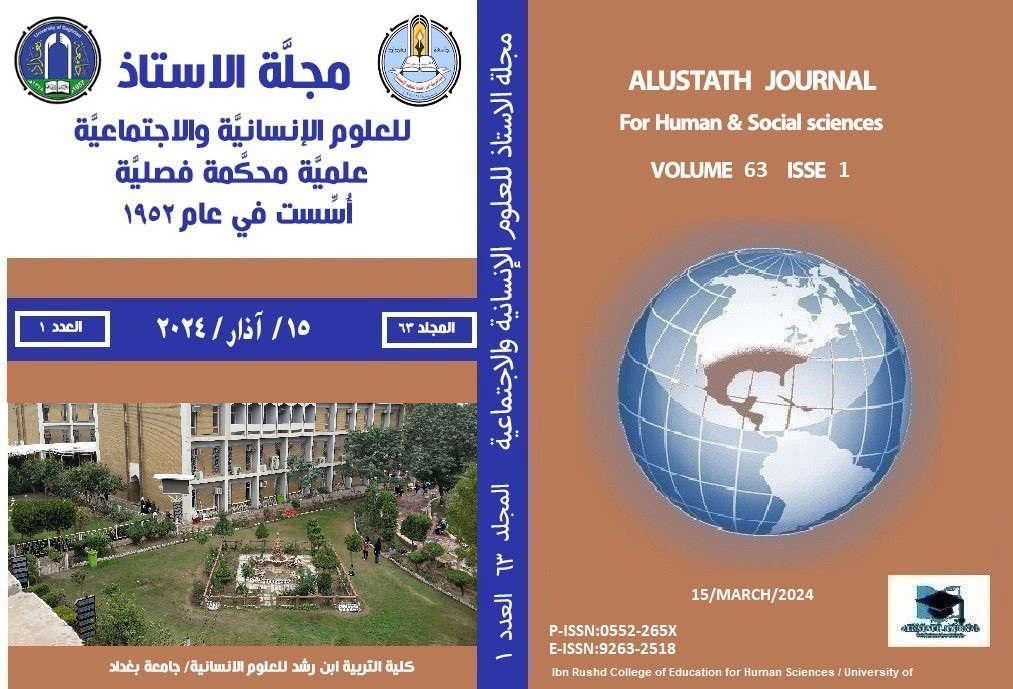تكوينات العلاقات المتصلة في الإنجليزية القديمة والإنجليزية الحديثة: دراسة مقارنة
DOI:
https://doi.org/10.36473/tnm5mp03الكلمات المفتاحية:
تشكيلات اقترانية ، ترتيب الكلمات في الإنجليزية القديمة، اللغويات المقارنةالملخص
تهدف هذه الورقة إلى استكشاف مبادئ تكوين وترتيب تشكيلات اقترانية في كل من اللغة الإنجليزية القديمة والإنجليزية الحديثة. ومن خلال مقارنة تشكيلات اقترانية في هذين العصرين اللغويين، نسعى إلى تحديد أوجه التشابه والاختلاف الرئيسية. تمت ملاحظة أنماط مختلفة من تشكيلات اقترانية في كل من اللغة الإنجليزية القديمة والإنجليزية الحديثة. بينما يجادل هيبرلي (2002) وبيكر (2012) بأن تشكيلات اقترانية في اللغة الإنجليزية القديمة تؤثر على ترتيب كلمات الجملة، يقترح رينج وتايلور (2015) أوجه التشابه بين اللغة الإنجليزية القديمة والإنجليزية الحديثة في تشكيلات اقترانية. لتسليط الضوء على هذا الموضوع، تتناول الورقة النثر الإنجليزي القديم (مع الترجمات إلى اللغة الإنجليزية الحديثة) وعينات من النصوص الإنجليزية الحديثة المعاصرة. تعتمد الدراسة على البحث الإحصائي المكثف الذي أجراه Cichosz (2021) لبيانات اللغة الإنجليزية القديمة وتجمع المقالات الإخبارية من الصحف الإنجليزية البارزة على الإنترنت للحصول على بيانات اللغة الإنجليزية الحديثة. تشير النتائج الأولية إلى أن العوامل الثقافية والاجتماعية واللغوية تؤثر بشكل كبير على تشكيلات اقترانية في كل من اللغة الإنجليزية القديمة والإنجليزية الحديثة.
التنزيلات
المراجع
References
Baker, P. (2012). Introduction to Old English. London: Blackwell.
Bately, J. M. (1988). Old English prose before and during the reign of Alfred. Anglo-Saxon England, 17, 93-138. doi:10.1017/S026367510000404X
Baugh, A. (1951). A History of the English Language. London: Routledge & Kegan Paul. pp. 60–83, 110–130 (Scandinavian influence).
Bean, M. (1983). The Development of Word Order Patterns in Old English. London: Croom Helm.
Bech, K. (2001). Word order patterns in Old and Middle English: A syntactic and pragmatic study. Unpublished Ph.D. dissertation, University of Bergen.
Bech, K. (2017). Old truths, new corpora: Revisiting the word order of conjunct clauses in Old English. English Language and Linguistics, 21(1), 1-25. doi:10.1017/S1360674315000465
Bjork, R., & Niles, J. D. (1997). A Beowulf Handbook. University of Nebraska Press.
Brown, W. H. (1969). Method and style in the Old English "Pastoral Care". The Journal of English and Germanic Philology, 68(4), 666-684.
Cichosz, A. (2017). Verb-initial main clauses in Bede: A translation effect? In A. Kijak, J. Nykiel, & A. M. Łęcki (Eds.), Current developments in English historical linguistics (pp. 68-89). Katowice: Wydawnictwo Uniwersytetu Śląskiego.
Cichosz, A. (2021). Verb-final conjunct clauses in Old English prose: The role of Latin in translated texts. NOWELE. North-Western European Language Evolution, 74(2), 172-198.
Cichosz, A., Gaszewski, J., & Pęzik, P. (2016). Element order in Old English and Old High German translations. Amsterdam: Benjamins. doi:10.1075/nss.28
Devine, A. M., & Stephens, L.D. (2006). Latin word order: Structured meaning and information. New York: Oxford University Press. doi:10.1093/acprof:oso/9780195181685.001.0001
Fischer, O., Kemenade, A. van, Koopman, W., & van der Wurff, W. (2000). The Syntax of Early English. Cambridge: Cambridge University Press.
Fuß, E., & Trips, C. (2002). Variation and change in Old and Middle English: On the validity of the Double Base Hypothesis. Journal of Comparative Germanic Linguistics, 4, 171-224. doi:10.1023/A:1016588502117
Haeberli, E. (2002). Observations on the loss of verb second in the history of English. In C. J. W. Zwart & W. Abraham (Eds.), Studies in comparative Germanic syntax (pp. 245–272). Amsterdam: Benjamins. https://doi.org/10.1075/la.53.15hae
Haeberli, E., & Pintzuk, S. (2012). Revisiting verb (projection) raising in Old English. In D. Jonas, J. Whitman & A. Garret (Eds.), Grammatical change: Origins, nature, outcomes (pp. 219–238). Oxford: Oxford University Press.
Halliday, M. A. K., & Hasan, R. (1976). Cohesion in English. London: Longman.
Hogg, R. (1992). Introduction. In R. Hogg (Ed.), Cambridge History of English Volume I (pp. 1-26). Cambridge: Cambridge University Press.
Kemenade, A. van (1987). Syntactic case and morphological case in the history of English. Dordrecht: Foris. https://doi.org/10.1515/9783110882308
Koopman, W. (1995). Verb-final main clauses in Old English prose. Studia Neophilologica, 67(2), 129–144. https://doi.org/10.1080/00393279508588156
Lemke, A. (2015). The Old English translation of Bede’s Historia Ecclesiastica Gentis Anglorum in its historical and cultural context. Göttingen: Georg-August-University. https://doi.org/10.17875/gup2015-787
Mitchell, B. (1985). Old English syntax. Oxford: Clarendon. https://doi.org/10.1093/acprof:oso/9780198119357.001.0001
Ohkado, M. (2000). Verb first constructions in Old English, with special reference to Bede’s Ecclesiastical history of the English people (pp. 263–278). In M. Amano & H. Nakano (Eds.), Synchronic and diachronic studies on language: A festschrift for Dr. Hirozo Nakano. Nagoya: Nagoya University.
Pintzuk, S. (1996). Old English verb-complement word order and the change from OV to VO. York Papers in Linguistics, 17, 241–264.
Pintzuk, S. (1999). Phrase structures in competition: Variation and change in Old English word order. New York: Garland.
Pintzuk, S. (2005). Arguments against a universal base: evidence from Old English. English Language and Linguistics, 9(1), 115–138. https://doi.org/10.1017/S1360674305001565
Pintzuk, S., & Haeberli, E. (2008). Structural variation in Old English root clauses. Language Variation and Change, 20(3), 367–407. https://doi.org/10.1017/S095439450800015X
Plummer, Ch. (Ed.) (1896). Venerabilis Beadae, Historiam Ecclesiasticam Gentis Anglorum. Oxford: Oxford University Press. (Available online at https://www.thelatinlibrary.com/bede.html)
Randall, B., Kroch, A., & Taylor, A. (2005–2013). Corpus Search 2. (Available online at corpussearch.sourceforge.net/CS.html).
Ringe, D., & Taylor, A. (2015). The development of Old English. Oxford: Oxford University Press.
Rowley, S. (2015). The long ninth century and the prose of King Alfred’s reign. Oxford Handbooks Online. Retrieved April 9, 2020, from https://www.oxfordhandbooks.com/view/10.1093/oxfordhb/9780199935338.001.0001/oxfordhb-9780199935338-e-53
Taylor, A. (2008). Contact effects of translation: Distinguishing two kinds of influence in Old English. Language Variation and Change, 20(3), 341–365. https://doi.org/10.1017/S0954394508000100
Taylor, A., Warner, A., Pintzuk, S., & Beths, F. (2003). The York-Toronto-Helsinki Parsed Corpus of Old English Prose (YCOE). Department of Linguistics, University of York. Oxford Text Archive. Available online at www-users.york.ac.uk/~lang22/YcoeHome1.htm
Van Gelderen, E. (2017). Analyzing Syntax through Texts Old, Middle, and Early Modern English. Edinburgh: Edinburgh Historical Linguistics
التنزيلات
منشور
إصدار
القسم
الرخصة
الحقوق الفكرية (c) 2024 رشوان صالح، باسمة محمود

هذا العمل مرخص بموجب Creative Commons Attribution 4.0 International License.











